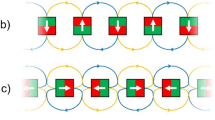Abstract
Background
Each GECAM satellite payload contains 25 gamma-ray detectors (GRDs), which can detect gamma-rays and particles and can roughly localize the Gamma-Ray Bursts (GRBs). GRD was designed using lanthanum bromide (LaBr3) crystal as the sensitive material with the rear end coupled with silicon photomultiplier (SiPM) array for readout.
Purpose
In aerospace engineering design of GRD, there are many key points to be studied. In this paper, we present the specific design scheme of GRD, the assembly and the performance test results of detectors.
Methods
Based on Monte Carlo simulation and experimental test results, the specific schematic design and assembling process of GRD were optimized. After being fully assembled, the GRDs were conducted performance tests by using radioactive source and also conducted random vibration tests.
Result and conclusion
The test results show that all satellite-borne GRDs have energy resolution <16% at 59.5 keV, meeting requirements of satellite in scientific performance. The random vibration test shows that GRD can maintain in a stable performance, which meets the requirement of spatial application.















Similar content being viewed by others
References
X.B. Han, K.K. Zhang, J. Huang et al., GECAM satellite system design and technological characteristic. Sci. China-Phys. Mech. Astron. 50, 129507 (2020). https://doi.org/10.1360/SSPMA-2020-0120
T.P. Li, S.L. Xiong, S.N. Zhang et al., Insight-HXMT observations of the first binary neutron star merger GW170817. Sci. China-Phys. Mech. Astron. 61, 031011 (2018). http://arxiv.org/abs/1710.06065
E. Bissaldi, A. von Kienlin, G. Lichti et al., Ground-based calibration and characterization of the Fermi gamma-ray burst monitor detectors. Exp. Astron. 24, 47–88 (2009)
S.D. Barthelmy, L.M. Barbier, J.R. Cummings et al., The Burst Alert Telescope (BAT) on the SWIFT Midex Mission. Space Sci. Rev. 120, 143–164 (2005)
A. von Kienlin, N. Arend, G.G. Lichti et al., A GRB detection system using the BGO-Shield of the INTEGRAL-Sectrometer SPI, in Gamma-Ray Bursts in Afterglow. ed. by E. Costa, F. Frontera, J. Hjorth (Springer-Verlag, Berlinm, 2001), pp. 427–430
R.L. Aptekar, D.D. Frederiks, S.V. Golenetskii et al., Konus-W gamma-ray burst experiment for the GGS Wind spacecraft. Space Sci. Rev. 71, 265–272 (1995)
K. Yamaoka, A. Yoshida, T. Sakamoto, et al. The CALET Gamma-ray Burst Monitor (CGBM). Article 41 in eConf C1304143, (2013)
X.Q. Li, X.Y. Wen, Z.H. An et al., The GECAM and its payload. Sci. Sin-Phys. Mech. Astron. 50, 129508 (2020). https://doi.org/10.1360/SSPMA-2019-0417
D.L. Zhang, X.Q. Li, S.L. Xiong et al., Energy response of GECAM gamma-ray detector based on LaBr3: Ce and SiPM array. Nuclear Instrum. Methods A 921, 8–13 (2019)
P. Lv, S.L. Xiong, X.L. Sun et al., A low-energy sensitive compact gamma-ray detector based on LaBr3 and SiPM for GECAM. JINST. 13, P08014 (2018)
R.-Y. Zhu, Precision crystal calorimeters in high energy physics: past, present and future, in AIP Conference Proceedings vol. 867, p. 61, (2006), https://doi.org/10.1063/1.2396939
A. Papa, P. Schwendimann, Development of new large calorimeter prototypes based on LaBr3(Ce) and LYSO crystals coupled to silicon photomultipliers: A direct comparison. Nuclear Instrum Methods A. 958, 162999 (2020). https://doi.org/10.1016/j.nima.2019.162999
F.G.A. Quarati, I.V. Khodyuk, C.W.E. van Eijk et al., Study of 138La radioactive decays using LaBr3 scintillators. NIMA 683, 46–52 (2012). https://doi.org/10.1016/j.nima.2012.04.066
D.Y. Guo, W.X. Peng, Y. Zhu et al., Energy response and in-flight background simulation for GECAM. Sci. Sin-Phys. Mech. Astron. 50, 129509 (2020). https://doi.org/10.1360/SSPMA-2020-0015
R. Klanner, Characterisation of SiPMs. Nuclear Instrum. Methods A 926, 35–56 (2019). https://doi.org/10.1016/j.nima.2018.11.083
Acknowledgments
The authors wish to thank Researcher Zhang Chunsheng, and thank Beijing Glass Research Institute for production and supplying of sealed LaBr3 crystals for GRD detectors; thank Shandong Aerospace Electronic Technology Research Institute for assistance in engineering, integrated test and experiment, etc., of detectors; and thank Northwest Rare Metal Materials Research Institute for assistance in supplying beryllium window. This research was supported by the National Natural Science Foundation of China, Grant No. 11775251, the strategic leading science and technology program of Chinese Academy of Sciences (Grant No. XDA 15360100, XDA 15360102).
Author information
Authors and Affiliations
Corresponding authors
Rights and permissions
About this article
Cite this article
An, Z.H., Sun, X.L., Zhang, D.L. et al. The design and performance of GRD onboard the GECAM satellite. Radiat Detect Technol Methods 6, 43–52 (2022). https://doi.org/10.1007/s41605-021-00289-y
Received:
Revised:
Accepted:
Published:
Issue Date:
DOI: https://doi.org/10.1007/s41605-021-00289-y




